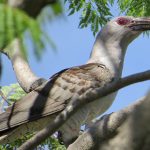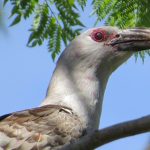CHANNEL-BILLED CUCKOO
The Channel-billed cuckoo is native to Australia, Indonesia, and Papua New Guinea. Channel-billed cuckoos are large birds, measuring about 58-66 cm in length. They have predominantly grey plumage with a distinctive large, curved bill that gives them their name. The bill is pale at the base and darker towards the tip. Their eyes are red, and they have a unique call.
These cuckoos are primarily found in the eastern and northern regions of Australia, as well as parts of Indonesia and Papua New Guinea. They are migratory birds, often moving within their range in response to changing seasons.
Channel-billed cuckoos are brood parasites, which means they lay their eggs in the nests of other bird species, leaving the host birds to raise their young. They often target species like crows and currawongs. The host bird unwittingly raises the channel-billed cuckoo chick, which typically grows much larger and faster than the host’s own chicks, sometimes outcompeting or ejecting them from the nest.
These cuckoos are known for their distinctive, eerie calls, often described as a series of drawn-out, melodious, and haunting “coo-ee” or “cu-cu-cu” sounds. These calls are often heard during their breeding season.
Channel-billed cuckoos primarily feed on fruits and insects. Their diet can vary depending on the season and food availability.
Channel-billed cuckoos typically arrive in Australia during the austral summer to breed. They lay their eggs in the nests of their host birds, and the hosts raise the channel-billed cuckoo chicks.
These cuckoos are fascinating birds, known for their unusual appearance, behavior, and vocalizations. Their brood parasitic lifestyle is a remarkable adaptation that allows them to exploit the efforts of other bird species in raising their young.


